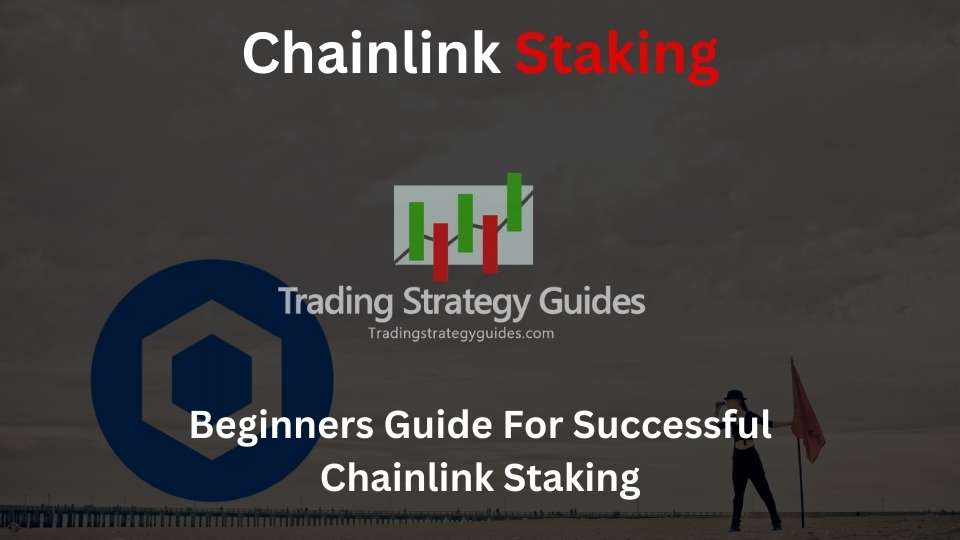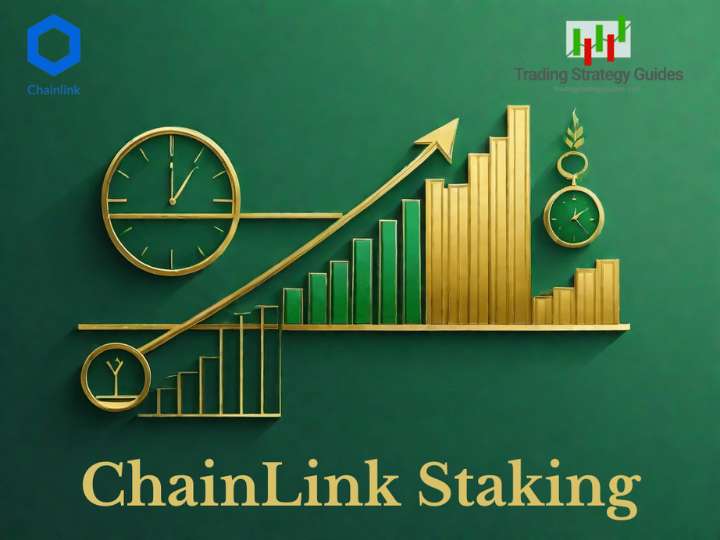Chainlink Staking: 5 Minute Beginners Guide For Success

Staking is a process that allows users to earn rewards for supporting the security and operation of a blockchain network and in the case of Chainlink, staking rewards node operators who provide real-world data to smart contracts.

Thanks for visiting Trading Strategy Guides (TSG)!
You have discovered the most extensive library of trading content on the internet. Our aim is to provide the best educational content to traders of all stages.
Learn Our Trading Best Strategy By our Founder Casey Stubbs
In other words, we want to make YOU a consistent and profitable trader.
If you’re a brand new trader, we recommend hopping over to our ultimate beginner’s guide to trading to learn more.
In this post, we will explore the staking of Chainlink in depth. We will cover the following topics:
Table of Contents
Definition of Chainlink Staking

Staking is the process of locking up a certain amount of cryptocurrency to participate in the security and operation of a blockchain network. In the case of Chainlink, staking rewards node operators provide real-world data to smart contracts.
When a user stakes LINK, they are committing their participation in the Chainlink network. Node operators who stake more LINK have a higher chance of being selected to provide data to smart contracts.
Staking rewards for Chainlink are paid in LINK, the native token of the network. Rewards can vary depending on the amount of LINK staked and the network’s performance.
Staking has transcended the confines of traditional blockchain networks, finding its way into the realm of decentralized finance (DeFi). DeFi staking involves locking up cryptocurrencies to participate in liquidity pools, which provide the necessary funds for various DeFi protocols to operate.
In return for staking their assets, DeFi stakers earn rewards in the form of the protocol’s native token or other cryptocurrencies.
Variants of DeFi Staking: Exploring Diverse Options
DeFi staking offers a diverse range of options to cater to the varying preferences and risk appetites of investors. Some common variants include:
- Flexible Staking: Allows stakers to withdraw their assets at any time without penalty.
- Fixed Staking: Requires stakers to lock up their assets for a predetermined period to earn higher rewards.
- Auto-Compounding Staking: Automatically reinvests rewards, maximizing earnings over time.
- Liquid Staking: Provides stakers with liquid tokens that can be used for other purposes while still earning rewards.
A brief introduction to Chainlink
Chainlink is a decentralized Oracle network that provides real-world data to smart contracts. Smart contracts are pieces of code that are automatically executed when certain conditions are met.
Chainlink uses a system of nodes to provide real-world data to smart contracts. Chainlink nodes are operated by individuals or businesses that have staked in LINK.
Chainlink is one of the most popular and widely used Oracle networks. It is used by a wide range of applications, including decentralized finance (DeFi), gaming, and supply chains. Crypto is popular now but remember you can also trade with a Trailing Stop in other types of trading.
Unveiling the Advantages of Staking with Chainlink
Chainlink staking has emerged as an attractive investment option for those seeking to participate in the decentralized finance (DeFi) ecosystem and contribute to the security and growth of the Chainlink network. Several compelling reasons make Chainlink staking a worthwhile consideration for investors:
1. Effortless Rewards for Network Support:
Staking with Chainlink offers a relatively straightforward approach to earning rewards while actively supporting the network’s infrastructure. Unlike other investment avenues that may require advanced technical knowledge or active trading strategies, Chainlink staking can be easily understood and implemented by individuals of varying technical expertise.
2. Long-Term Investment with Predictable Returns:
Staking with Chainlink presents a long-term investment opportunity, providing investors with a predictable stream of rewards over a predetermined period. This stability and predictability contrast with the volatility often associated with traditional investment markets, making Chainlink staking an attractive option for risk-averse investors seeking consistent returns.
3. Substantial Passive Income Potential:
The potential for generating significant passive income is a key driving force behind the popularity of Chainlink staking. Staking rewards are typically distributed in LINK, the native token of the Chainlink network.
These rewards can be substantial, depending on the amount of LINK staked and the overall performance of the network.
4. Alignment with the Growth of Decentralized Finance:
Chainlink plays a pivotal role in enabling the growth and expansion of DeFi applications. By providing secure and reliable Oracle data, Chainlink facilitates the seamless integration of real-world data into smart contracts, powering a wide range of DeFi protocols.
Staking with Chainlink aligns investors with the growth of this burgeoning sector, offering exposure to its potential for long-term value creation.
5. Contribution to a Secure and Decentralized Network:
Staking with Chainlink directly contributes to the security and decentralization of the network. By locking up LINK tokens, stakers increase the overall stake in the network, making it more resilient against malicious attacks and ensuring the integrity of data feeds.
This participation fosters trust and confidence among network users, further strengthening the Chainlink ecosystem.
6. Diversification of Investment Portfolios:
Chainlink staking offers a valuable opportunity to diversify investment portfolios, reducing overall risk exposure. By allocating a portion of their assets to staking, investors can participate in the growth of the blockchain space while mitigating the risks associated with traditional investment markets.
7. Support for Innovation and Ecosystem Development:
Staking rewards provide Chainlink with the necessary resources to continue innovating and developing its Oracle network. By supporting the growth of the Chainlink ecosystem, stakers contribute to the advancement of blockchain technology and the expansion of its applications across various industries.
Preparations for staking
Before you can start staking Chainlink, you need to make some preparations.
Staking is a process by which cryptocurrency holders can earn rewards for locking up their coins and helping to secure the network. DeFi staking differs from traditional staking in that it does not require users to run their own nodes.
Instead, users can stake their cryptocurrency through a DeFi protocol, which will handle the technical aspects of staking. This makes DeFi staking more accessible and affordable for users who do not have the technical expertise or resources to run their own nodes.
DeFi staking carries some risks, including:
- Volatility: The price of cryptocurrencies can be volatile, which can affect the value of your rewards.
- Loss risk: If the DeFi protocol is hacked, you could lose your staked cryptocurrency.
- Impermanent loss: If the price of the cryptocurrency you are staking changes significantly, you could lose money.
Before participating in DeFi staking, it is important to do your research and understand the risks involved. Here are some tips for preparing for DeFi staking:
- Do your research: Learn about different DeFi staking protocols and compare their fees, rewards, and risks.
- Choose a reputable protocol: Not all DeFi protocols are created equal. Choose a protocol that has a good reputation and a track record of security.
- Start small: If you are new to DeFi staking, start with a small amount of cryptocurrency. This will help you minimize your risks.
DeFi staking, while profitable, requires thorough preparation to mitigate risks and maximize potential rewards. Conduct extensive research on DeFi protocols, selecting those with a solid reputation and comprehensive security measures. Start with a small investment to gain experience and familiarity, and be prepared for market fluctuations.
Diversify your portfolio across multiple protocols to minimize risk exposure. Carefully review staking terms, including lock-up periods, reward structures, and associated fees. Practice patience and avoid chasing quick riches, as DeFi staking is a long-term investment strategy.
How to stake Chainlink step-by-step
Once you have meticulously selected your staking platform, you can embark on the journey of staking your LINK and begin reaping the rewards of your decision. By entrusting your LINK tokens into the secure and reliable platform you have chosen, you become an active participant in the decentralized network, contributing to its stability, and earning passive income through LINK rewards.
Step 1: Register for a staking platform
Once you have researched and chosen a staking platform, you will need to register to create an account and start staking your LINK tokens.
The registration process is simple and straightforward. You will need to provide some basic information, such as your name, email address, and password. Once you have registered, you can deposit your LINK tokens and begin earning rewards.
Step 2: Deposit LINK into the platform
Upon successful registration, you will need to transfer your LINK tokens into the staking platform. This straightforward process involves linking your external wallet containing LINK tokens to the platform and initiating a transfer. Once your LINK tokens are deposited, they will be securely held by the platform and utilized for the staking process.
Step 3: Configure your staking preferences
Once you have successfully registered and deposited your LINK tokens, you will need to configure your staking preferences. This is an important step in the staking process, as it allows you to customize your participation and maximize your rewards.
The first preference you will need to set is the amount of LINK you want to stake. This will determine your contribution to the network’s security and the corresponding rewards.
In general, the more LINK you stake, the greater your contribution and the higher your rewards will be. However, it is important to note that staking a larger amount of LINK also means that your tokens will be locked up for a longer period of time.
The second preference you will need to set is the staking period. This is the duration for which your tokens will be locked up and earning rewards. The staking period is typically between 30 and 90 days. The longer the staking period, the higher your rewards will be. However, it is important to note that you will not be able to access your tokens during the staking period.
Here are some factors to consider when configuring your staking preferences:
- Your investment goals: If you are looking to maximize your rewards, you should stake a large amount of LINK for a long staking period. However, if you need to be able to access your tokens at any time, you should stake a smaller amount of LINK for a shorter staking period.
- Your risk tolerance: Staking a larger amount of LINK for a longer staking period carries more risk, as you will not be able to access your tokens for a longer period of time. If you are risk-averse, you should stake a smaller amount of LINK for a shorter staking period.
- The current market conditions: The staking rewards offered by platforms can fluctuate depending on the current market conditions. It is important to research the different platforms and compare their staking rewards before making a decision.
By carefully considering these factors, you can configure your staking preferences to meet your individual needs and goals.
Step 4: Start the staking process
Once you have confirmed your decision, the staking process will begin. Your LINK tokens will be locked up and will begin earning rewards. The amount of rewards you earn will depend on your staking amount, staking period, and the current market conditions.
Major staking platforms for Chainlink
Chainlink is a decentralized Oracle network that provides real-world data to smart contracts. Staking is the process of locking up a certain amount of LINK, the native cryptocurrency of Chainlink, to earn rewards. Many different staking platforms offer staking on Chainlink, each with its own features and rewards.

Here are some of the most popular staking platforms for ChainLink:
| **Platform | Estimated Annual Percentage Yield (APY)** |
| Binance Staking | Up to 12.74% |
| Coinbase Staking | Up to 6% |
| Kraken Staking | Up to 21% |
| Lido | Up to 5.3% |
| Stakefish | Up to 10% |
It is important to note that these are just estimates, and the actual APY you earn will depend on several factors, such as the amount of LINK you stake, the performance of the Chainlink network, and the specific staking platform you use.
Here is a more detailed comparison of the features and rewards of each platform:
| **Platform | Features | Rewards** |
| Binance Staking | Flexible and fixed staking options | Up to 12.74% APY |
| Coinbase Staking | Easy to use and secure | Up to 6% APY |
| Kraken Staking | High APYs and flexible staking options | Up to 21% APY |
| Lido | Liquid staking and no minimum staking requirement | Up to 5.3% APY |
| Stakefish | Experienced team and focus on institutional investors | Up to 10% APY |
Rise of Chainlink staking in recent years
Staking of Chainlink has witnessed a remarkable surge in popularity in recent years, driven by a confluence of factors that have significantly enhanced its appeal among investors and network participants. Let’s delve into the key catalysts behind this upward trajectory:
1. The Burgeoning Decentralized Finance (DeFi) Landscape:
Chainlink serves as a cornerstone of the DeFi ecosystem, providing a secure and reliable Oracle network that bridges the gap between real-world data and smart contracts. As DeFi has gained widespread traction, the demand for Chainlink’s services has skyrocketed, consequently propelling the need for LINK staking.
2. LINK’s Price Appreciation:
The price of LINK has experienced substantial growth in recent years, further incentivizing investors to participate in staking. As the value of LINK has increased, the potential rewards for staking have become more attractive, drawing in a wider pool of participants.
3. Proliferation of Staking Platforms:
The availability of staking platforms has expanded significantly, making it easier for users to engage in Chainlink staking. With a growing number of platforms offering staking services, users have greater flexibility and options to choose from, catering to their specific needs and preferences.
4. Diversification of Investment Strategies:
Staking has emerged as a valuable tool for investors seeking to diversify their portfolios and generate passive income. By locking up LINK for staking, investors can earn rewards while mitigating the risks associated with active trading.
5. Growing Awareness and Community Engagement:
The rising popularity of Chainlink and the increasing awareness of staking opportunities have attracted a broader community of users and investors. This expanding community actively engages with staking platforms, contributing to the overall growth and development of the Chainlink ecosystem.
Impact on the cryptocurrency community
Staking in Chainlink has had a positive impact on the cryptocurrency community. It has helped to increase user participation in the Chainlink network, which has helped to improve its security and reliability.

Staking on Chainlink has also helped to increase awareness of cryptocurrencies. It has been shown that cryptocurrencies can be used to generate passive income, which has attracted new investors to the community.
The potential of Chainlink staking
Chainlink staking holds immense potential for long-term growth and value creation, aligning with the expanding role of Chainlink as a critical component of the blockchain ecosystem. Let’s explore the key aspects that underscore this promising outlook:
1. Growing Importance of Staking in the Chainlink Network:
As Chainlink continues to expand its reach and influence within the blockchain landscape, staking will play an increasingly pivotal role in maintaining the network’s security, reliability, and scalability. By incentivizing node operators to stake LINK, Chainlink ensures that the network remains decentralized and robust, fostering trust and confidence among users.
2. Enhanced Network Security and Reliability:
Staking plays a crucial role in safeguarding the Chainlink network against malicious activities and ensuring the integrity of Oracle data. By requiring node operators to stake LINK, Chainlink aligns their financial interests with the network’s well-being, deterring potential attacks and maintaining the integrity of data feeds.
3. Sustainable Economic Model:
Staking contributes to the establishment of a sustainable economic model for Chainlink, enabling the network to fund its ongoing development and operations. By distributing staking rewards to participants, Chainlink incentivizes continued engagement and support for the network, fostering its long-term growth and success.
4. Potential for Passive Income Generation:
Chainlink staking offers investors a compelling opportunity to generate passive income by locking up their LINK tokens. Staking rewards are typically distributed in LINK, allowing investors to earn additional LINK over time while contributing to the network’s security and growth.
5. Alignment with the Decentralized Finance (DeFi) Ecosystem:
As DeFi applications continue to gain traction, the demand for reliable and secure Oracle data will rise in tandem. Chainlink staking plays a critical role in ensuring the availability of this data, positioning it as an essential component of the DeFi ecosystem.
6. Expanding Use Cases and Applications:
Chainlink’s applications extend beyond DeFi, encompassing a wider range of blockchain-based use cases, including supply chain management, insurance, and gaming. As Chainlink adoption expands across these sectors, the demand for staking will continue to grow, further solidifying its potential.
Tips and best practices for beginner stakers
If you are interested in staking Chainlink, here are some tips and best practices for beginner stakers:
- Do your research. Before you start staking, make sure you understand how staking works and the risks involved. There are many resources available online and in the Chainlink community that can help you learn more about staking.
- Start with a small amount. You don’t need to stake a large amount of LINK to start. You can start with a small amount to get familiar with the process and see how it works.
- Diversify your investments. Don’t put all your eggs in one basket. It is important to diversify your investments to reduce your risk. You can stake on different platforms or on different types of nodes.
- Be patient. Staking is a long-term investment. Don’t expect to get rich quickly.
How To Stake Chainlink On Coinbase
Coinbase is a leading cryptocurrency exchange platform that empowers users to seamlessly buy, sell, store, and manage various digital currencies. It offers a user-friendly interface, a wide range of cryptocurrencies, secure storage solutions, multiple payment options, and dedicated customer support, making it an ideal choice for both novice and experienced crypto enthusiasts.
Coinbase Staking is a secure and convenient way to earn passive income on your cryptocurrency holdings. By staking eligible assets, you can contribute to the validation and security of blockchain networks and receive rewards in the form of additional cryptocurrency. Coinbase handles the technical aspects of staking, making it easy for anyone to participate.
Step-by-Step Guide to Staking on Coinbase
- Step 1, Create a Coinbase Wallet Account: If you don’t already have one, create a Coinbase Wallet account. This will be where you store your cryptocurrency assets.
- Step 2, Deposit Eligible Assets: Deposit the cryptocurrency assets you want to stake into your Coinbase Wallet.
- Step 3, Navigate to Staking Dashboard: Go to the staking dashboard on Coinbase.com or in the Coinbase Wallet app.
- Step 4, Choose Staking Asset: Select the cryptocurrency asset you want to stake.
- Step 5, Review Staking Details: Carefully review the staking details, including the lock-up period, estimated annual percentage yield (APY), and any associated fees.
- Step 6, Select Staking Amount: Enter the amount of cryptocurrency you want to stake.
- Step 7, Confirm Staking: Review the confirmation screen and click the “Stake” button to lock up your assets and start earning rewards.
- Step 8, Monitor Staking Rewards: Track your staking rewards through the staking dashboard or your Coinbase Wallet account.
Conclusion: Staking Chainlink
The rise of Chainlink staking can be attributed to several factors, including the burgeoning DeFi landscape, LINK’s price appreciation, the proliferation of staking platforms, diversification of investment strategies, and growing awareness and community engagement. These factors have fueled the adoption of staking, making it an integral component of the Chainlink ecosystem.
As Chainlink staking continues to gain traction, it is poised to play an increasingly crucial role in the DeFi ecosystem, providing a sustainable economic model and expanding the use cases and applications of Chainlink’s oracle services. With its growing importance and potential, Chainlink staking presents a compelling opportunity for investors to participate in the future of decentralized finance.
Chainlink Staking FAQ
Is there staking for Chainlink?
Yes, Chainlink does not have a native staking mechanism. However, there are third-party platforms and protocols that allow users to stake their Chainlink tokens (LINK) for various purposes, such as earning rewards or participating in network governance. Some examples include staking on decentralized finance (DeFi) platforms or participating in validator nodes on blockchain networks that support Chainlink. When considering staking options, it is important to conduct thorough research and consider the associated risks.






